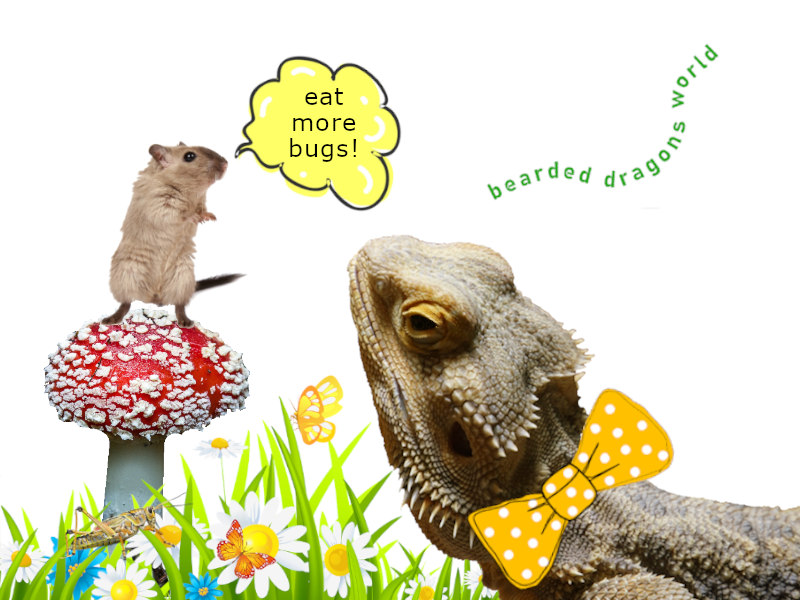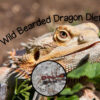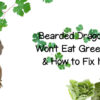Bearded dragons eat mice, or more acurately, pinkies. Pinkies, the name given to newborn mice, are small and weigh a gram or two. Pinkies are transition to becoming ‘fuzzies’ as they grow fur and gain a little weight. Between 5-9 days of age, mice become juveniles and are called fuzzies as they develop fur and weigh around 3 to 6 grams.
Bearded dragons do not need to eat mice and their inclusion in the diet can create some issues. Limit the consumption of pinkies to an occasional treat, perhaps once every few weeks.
Obesity in captive reptiles is a significant problem. When bearded dragons eat mice it adds to the rich foods with excessive calories that they may have access to.

Jump To…
Calcium & Fat Content of Mice and Pinkies
Mice pinkies do not provide a great source of calcium since their skeletal structure has not calcified. A mouse pup is essentially 1.1:1 calcium to phosphorus ratio. Once their bones have developed as adults their ratio of calcium to phosphorus increases to 1.4:1 (bearded dragons require 2:1). However, at this stage they are too large and furry to feed a bearded dragon.
| Age | Grams | Energy (kcal/g) | Protein (% kcal) | Fat (% kcal) | Calcium (mg/kcal) | Phosphorus (mg/kcal) |
|---|---|---|---|---|---|---|
| Mouse adult | 27 | 65 | 1.7 | 47 | 5 | 3.6 |
| Mouse pup | 4 | 1.7 | 29 | 69 | 2.4 | 2.2 |
Stahl and Donoghue (2010)
Bearded Dragons Eat Mice: Frequency & Guidelines
Feeding Mice to Bearded Dragons
Bearded dragons are primarily insectivores but can consume an occasional mouse as a source of protein and fat. Offering mice to adult bearded dragons should be infrequent; a guideline is no more than once every two weeks (Raiti, 2012).
How Often Can Bearded Dragons Eat Mice?
Bearded dragons can eat mice (pinky) sparingly due to their high-fat content. When included, one pinky mouse per offering is sufficient, ensuring it remains a minor part of a diverse diet. Ideally, if they are to be offered, bearded dragons eat mice every 2-4 weeks. Pinkies may benefit females post-egg laying due to higher nutritional demands. Feeder mice diseases are a concern, so sourcing from reputable providers is crucial.
- Frequency: Occasional treats, 1 pinkie every 2-4 weeks
- Risks: Potential to introduce zoonotic diseases
- Alternatives: Range of arthropods (insects)
When Can Bearded Dragons Eat Mice?
Bearded dragons can eat mice (pinkies) when they are fully mature. Juvenile bearded dragons should not be fed mice. Maintain juveniles on arthropods which are more in alignment with their need for dietary needs.
Are Bearded Dragons Supposed to Eat Mice?
While pinky mice offer protein, so do insects. Pinkies lack necessary calcium and can contribute to health issues like gout if fed excessively. An appropriate balance of insects and vegetation offers better long-term health outcomes for bearded dragons.
Adult bearded dragons primarily consume prey that moves slowly. Mice, being nimble and quick, are generally not part of their diet in their native Australian habitat. In addition, mice are an introduced species to Australia.
Existing research on the dietary habits of wild bearded dragons has not provided evidence of mice or other vertebrates in their stomach content. Nonetheless, it is common for bearded dragons in captivity to consume any vertebrate they can capture or encounter dead or alive. This suggests that similar behavior may occur in their natural habitat.
Here’s an overview of their feeding habits:
- Prefer slow-moving insects
- Mice are considered fast-moving prey
- Typical wild diet does not include vertebrates
Solid evidence indicates that bearded dragons can achieve a long lifespan when provided with a balanced diet of insects and plants. While bearded dragons can eat mice during periods of biological strain, like post-egg-laying, there is a tendency to overfeed them, especially with high-fat foods. Gout is alarmingly common among captive bearded dragons, and red meat may contribute to this issue.
Feeding Live Mice to Bearded Dragons
When offering prey to bearded dragons, it’s crucial to prioritize the welfare of both the reptile and the rodent.
Feeding live mice to bearded dragons is an unnecessary cruelty to animals and endangers the reptile (Redrobe, ND). Mice, like all creatures, will attempt to defend themselves and a bite can cause a lot of damage. If mice are to be fed, use humanely killed prey. Pinkies cannot fight back so the harm of feeding live pinkies is an ethical issue more than harm to the bearded dragon.
Feeding Method:
- Use frozen pinky mice.
- Defrost in warm water to gently bring it to room temperature before offering.
Animal Welfare Considerations:
- Humanely kill rodents, adhering to moral approaches respected in veterinary practices.
- Feeding live prey should always be the last resort to prevent unnecessary stress and possible injury to both parties involved.
Storing Killed Mice
Frozen mice need to be used within six months and should be kept in heavy-duty plastic bags to slow down spoilage. Store frozen mice at -20°C (Nijboer, 2020).
The thawing technique should preserve moisture content of the mice. Thaw in a cooler environment, at temperatures below 8°C.
Bearded Dragons Eat Mice with Zoonotic Diseases
Feeding bearded dragons mice can carry health risks and potential for zoonotic diseases—illnesses that can be transmitted from animals to humans.
Mice pups supplied to the pet industry have been associated with at least two zoonotic disease being salmonella and Multistate Lymphocytic Choriomeningitis Virus (LCMV). LCMV can spread not just to humans but also to other animals.
Salmonella outbreaks in humans have been associated with frozen rodents in the US (CDC 1) and the European Centre for Disease Prevention and Control is directly associating consistent outbreaks of salmonella since 2012 with feeder mice (ECDC).
In the United Kingdom a study by Marin et al (2018) found that 28% of 295 mice intended for feeding reptiles (including pinkies, fuzzies, small, large and extra large) were positive for Salmonella.
An outbreak of LCMV in the US in 2012 was directly associated with mice. Infection of LCMV was put down to the poor conditions the animals had to endure. Over 301,000 mice from the infected facility were shipped to 543 pet stores, 11 breeders and 7 zoos/aquariums. Once the infection was detected by authorities, action was taken to eradicate the disease including putting down thousands of mice, not just those at the facility but all the additional mice that were infected as they intermingled with other stock in pet stores and other locations. Unfortunately mice were not the only victims in the outbreak, other animals were also euthanized.
Key Points:
- Salmonella and Lymphocytic Choriomeningitis Virus (LCMV) are two notable zoonotic diseases that have been linked to feeding rodents to pet reptiles.
- Studies have identified salmonella bacteria in a significant proportion of feeder mice (Marin et al, 2018). This study raised concerns after finding a high prevalence of bacteria in mice meant for reptile consumption.
- The spread of LCMV can affect not only humans but other animals as well, necessitating vigilant safety practices when handling feeder mice.
- A past outbreak in the US led to the authorities taking stringent measures against LCMV after tracing it back to one facility that had distributed over 300,000 feeder mice to various outlets. This outbreak necessitated drastic sanitary actions as detailed in the CDC’s interim guidance.
- The European Centre for Disease Prevention and Control has also highlighted ongoing salmonella risks associated with feeder mice since 2012.
- A distressing incident in May 2005 involved organ transplant recipients contracting LCMV, leading to three fatalities within a month post-operation.
Safety Recommendations:
- Veterinarians typically advise pet owners to practice good hygiene when handling feeder mice and any other pet-related items.
- Bacterial growth in improperly handled or stored feeder mice can pose serious health issues. Hence, reptile owners should ensure their pet’s food is sourced from reputable suppliers.
- Awareness of reported cases of disease transmission linked to feeder mice can help mitigate health risks.
This video comes from PeTAs story on Pet Store Mice Prove Deadly by Michelle Kretzer 23-8-2012 where it was found that mice (along with hamsters and other unfortunate animals) were infected with Multistate Lymphocytic Choriomeningitis Virus.
WARNING: This video shows animal cruelty and is distressing to watch. It raises concerns on the treatment and conditions of animals in the pet trade.
Bearded Dragons Eat Mice Conclusion
Yes bearded dragons eat mice (pinkies) but the feeding of excessive foods can cause health issues which grow over time, sometimes years before it becomes apparent.
In addition, feeding bearded dragon mice has the risk of introducing zoonotic diseases if not obtained from a clean source.
Providing a wide range of foods in a bearded dragons diet is key to balance.
Do Bearded Dragons Eat Mice?
Yes bearded dragons eat mice, more specifically pinkies (not adult mice). However, pinkies are a rich food and not suitable as a staple food item. Pinkies should only be fed to adult bearded dragons.
How many pinky mice can a bearded dragon eat?
Pinkie mice are considered a treat, not a staple. Feeding a bearded dragon 1 pinkie every few weeks is sufficient for a treat.
Should bearded dragons eat mice?
Bearded dragons should not eat mice but they can eat pinkies. However, it is a pet owners choice and not necessary nor a natural part of their diet. A bearded dragons core diet consists of leafy greens, vegetables, and insects. Mice can also carry disease and outbreaks of diseases such as Salmonella have been associated with feeder mice.
References
- CDC. Multistate Outbreak of Human Salmonella I 4, [5],12 Infections Associated with Frozen Rodents (Final Update)
- CDC. Update: Interim Guidance for Minimizing Risk for Human Lymphocytic Choriomeningitis Virus Infection Associated with Pet Rodents
- “In May 2005, CDC received reports of illness in four solid-organ transplant recipients who were later determined to have been infected with lymphocytic choriomeningitis virus (LCMV) from a common organ donor (1). Three of the four organ recipients died, 23–27 days after transplantation…”
- ECDC. Multi-country outbreak of Salmonella Enteritidis PT8 infection, MLVA type 2-10-8-5-2,associated with handling of feeder mice. European Centre for Disease Prevention and Control. 2016
- Edison, L., Knust, B., Petersen, B., Gabel, J., Manning, C., Drenzek, C., Stroher, U., Rollin, P. E., Thoroughman, D., Nichol, S. T., and the Multistate LCMV Outbreak Working Group. (2014) Trace-Forward Investigation of Mice in Response to Lymphocytic Choriomeningitis Virus Outbreak. Emerging Infectious Diseases. 20(2):291-295.
- Marin, C., Martelli, F., Rabie, A., and Davies, R. (2018) Commercial Frozen Mice Used by Owners to Feed Reptiles are Highly Externally Contaminated with Salmonella Enteritidis PT8. Vol 18(9).
- Nijboer, J. (2020) Nutrition in Reptiles – Management and Nutrition. (n.d.). MSD Veterinary Manual.
- Redrobe, S. BVetMed BSc MRCVS (ND) The Reptile Patient. Vet On-Line Priory Lodge Education
- Raiti, P. (2012). Husbandry, Diseases, and Veterinary Care of the Bearded Dragon (Pogona vitticeps). Journal of Herpetological Medicine and Surgery, 22(3-4), 117–131.
- Stahl, S., and Donoghue, S. (2010) Nutrition of Reptiles. In: Hand MS, Thatcher CD, Remillard RL, et al, editors. Small Animal Clinical Nutrition. Topeka (KS): Mark Morris Institute pp 1237-1249





